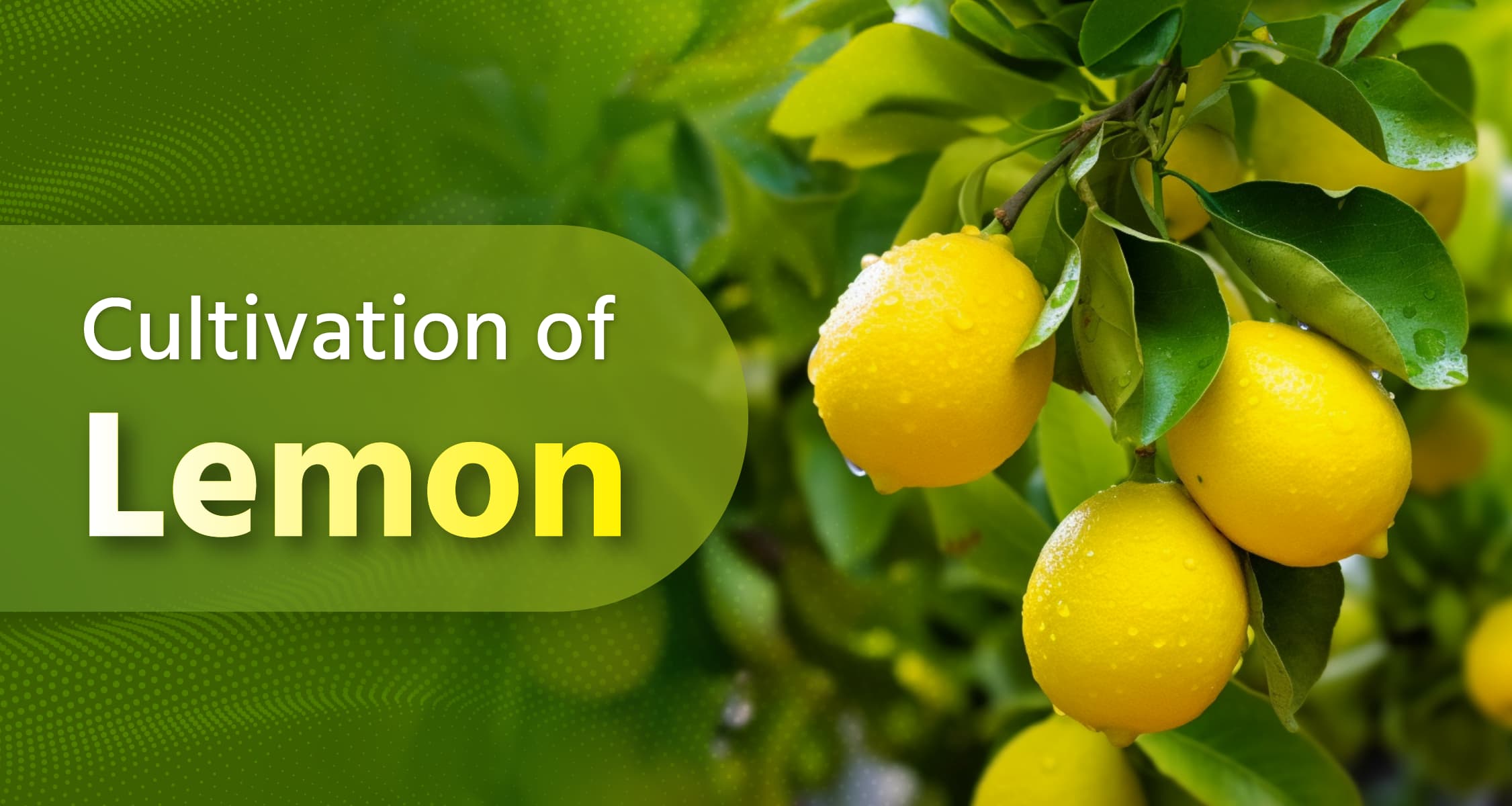Cultivation of Lemon

Lemon is cultivated in almost all regions of India. Lemons are rich in vitamin C and are an important fruit crop. In India, citrus cultivation is done on approximately 923 thousand hectares, resulting in an annual production of 8608 thousand metric tons. In Punjab, lemons are grown on 39.20 hectares of land.
How to Cultivate Lemons?
Soil
- Light loamy soil with good drainage is best for lemons. The pH level of the soil should be between 5.5 and 7.5. Avoid cultivating in heavy soil. They can also be grown in slightly alkaline and acidic soils.
Climate
- For good yield, it is suitable to cultivate lemons in intermediate humid climates.
Varieties
- Selecting improved varieties of lemons results in better outcomes. Famous varieties like Punjab Baramasi and Eureka are known for good production and fruit quality. The Punjab Baramasi variety has good fruiting capacity and disease resistance, while the Eureka variety is known for its excellent taste and size. Farmers can achieve better crops and higher market value by selecting these varieties.
Sowing Time
- The most suitable time for lemon planting is during the months of July and August. During this period, the seasonal conditions favor plant growth and development. This season provides adequate moisture and the right temperature, which helps the roots establish quickly and promotes better growth. Sowing at the right time gives plants more time to grow strong and healthy, even in winter.
Inter-cropping
- During the first two to three years of lemon cultivation, inter-cropping with cowpeas, vegetables, and French beans can be done. This provides additional income and helps maintain soil fertility.
Seed Quantity
- Maintain a density of 208 plants per acre. Proper density ensures that plants receive adequate space and resources, which improves the quality and yield of the crop.
Field Preparation
- Plow the field 2 to 3 times. This loosens the soil and aids in root growth. Prepare pits 75 centimeters wide and 75 centimeters deep at a distance of 4 to 5 meters. Leave the pits open for a few days to balance moisture and other elements. For new plants, the size of the pits should be 60x60x60 cm. Add 10 kg of decomposed cow dung and 500 grams of single superphosphate to each pit. Transplant the nursery-prepared plants into the pits. Maintain a spacing of 4.5x4.5 meters between the plants. Fill all pits with an equal mixture of decomposed cow dung and soil. Before transplanting, add 2 milliliters of chlorpyrifos per liter of water to each pit.
Irrigation Management
- Lemon plants do not require frequent irrigation. Water every 25 to 30 days during the cold season. In the summer season, water every 8 to 10 days. Usually, irrigation is not needed during the rainy season.
Weed Control
- Keep the field free from weeds. Regularly remove weeds through hoeing and weeding.
Major Pests and Their Prevention
Citrus psyllid
- These are sap-sucking insects that cause significant damage. They secrete a liquid on the plant that causes leaves and fruit peels to burn. Leaves curl and fall off prematurely. Prevention can be achieved by pruning and burning the affected plants.
Leaf Miners
- These insects lay larvae inside the surface of new leaves, causing the leaves to appear curled and deformed. Infestations can stunt the growth of new plants. For effective management, it's best to leave the leaf miners alone as they become food for natural predators that consume their larvae.
Aphids and Mealybugs
- These small insects suck the sap from plants. They are usually found on the inner parts of the leaves.
Major Diseases and Their Prevention
- Citrus Canker Disease: Plants develop brown, water-soaked spots on stems, leaves, and fruits. The citrus canker bacteria enter the plant through protective cells, with new leaves being the most affected. These bacteria can spread to healthy plants through wind in the area. Contaminated tools can also transmit this disease to healthy plants. The bacteria can remain on old wounds for several months, which can be identified by their presence. This disease can be controlled by cutting off the affected branches.
- Leaf Spot Disease: White, cotton-like spots appear on the upper parts of the plant. Leaves turn light yellow and curl. Distorted lines are visible on the leaves, with the upper surface being more affected. New fruits fall before ripening, leading to reduced yield. To prevent leaf spot disease, remove and destroy the affected parts of the plant.
- Zinc Deficiency: This is a common deficiency in lemon trees. It appears as yellow patches in the middle vein and veins of the leaves. Root rot and bushy branches can also be observed. The fruit turns yellow, becomes elongated, and shrinks in size. To address zinc deficiency in lemon trees, appropriate amounts of fertilizers should be applied. Zinc sulfate can be mixed with 2 teaspoons in 10 liters of water. This solution can be sprayed on the entire tree, including branches and green leaves.
- Iron Deficiency: Symptoms of iron deficiency include new leaves turning yellow-green. Cattle and sheep manure can help prevent iron deficiency in plants. This deficiency is mostly due to alkaline soil.
Harvesting
- The fruits are ready for harvest in about 6 months. When the fruits start turning from green to yellow, harvesting should begin. Take special care during harvesting to avoid damaging the lemon peels. The fruits should be picked with about 1 centimeter of the branches attached.
Storage
- After harvesting, the fruits can be stored at normal temperature for 8 to 10 days.
Yield
- The yield of lemons depends on the variety. Plants that are 5 to 6 years old can produce 2,500 to 6,000 lemons per year.
Do you grow lemons? Share your answer and experience with us in the comments. For more such interesting and important information, follow the 'Krishi Gyan' channel now. And if you found the post informative, don't forget to like it and share it with your fellow farmers.
Frequently Asked Questions (FAQs)
Q: How many years does it take for a lemon tree to bear fruit?
A: Lemon trees start to bear fruit three to three and a half years after planting. While they begin to bear fruit three years after planting, a lemon tree starts producing around 100 kilograms of fruit after five years.
Q: How long does it take for lemon trees to flower?
A: Lemon trees produce beautiful, white, fragrant flowers that can appear throughout the year but are more abundant at the end of winter. The fruit takes about 12 months to ripen, so flowers and fruits can appear on the trees at the same time.
Q: Which lemon tree variety is the best?
A: The best lemon variety is the Kagzi Baramasi. Farmers can contact the horticulture department’s nursery to obtain Kagzi lemon plants.
Please login to continue

Get free advice from a crop doctor
